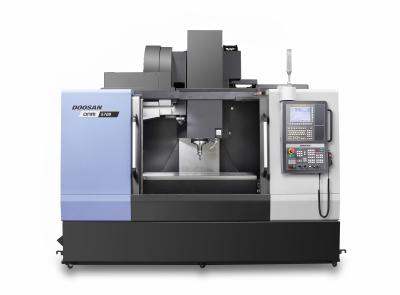
Doosan Machine Tools America has evolved its popular and field-proven “DNM” series of vertical machining centers. According to Ron Kilgore, Doosan’s general manager - inside sales, the new series is the third generation of this particular VMC line. “Some of the aspects of the new VMCs to highlight are that we’ve stepped up the speed with faster spindle acceleration and deceleration rates. We’ve also upgraded the Doosan FANUC OiMF control, which provides quicker processing speed. Rigid roller guideways and a new grease-based lubrication system that requires a refill only every 3 to 6 months rather than every few days with oil, which cuts down on a customer’s time, expenses and also improves the factory environment and disposal issues. We also have applied a cyclone coolant filter, which eliminates changing the conventional bag-type, which is easy to forget to do and problems can ensue. The new DNM VMCs are general-purpose, workhorse machines for customers who need robust and accurate performance. In fact, we refer to them as the ‘Global Standard’.”
The new DNM series is comprised of three machines, the DNM 4500, 5700 and 6700, stepped up in size and capacity. In general the series offers larger cutting space by 6 percent, bigger table sizes by 14 percent and heavier loads by 25 percent while maintaining the same overall footprint as the previous generation. For the three models, the X-axis travel is 800 mm (31.5 in.), 1050 mm (41.3 in.), and 1300 mm (51 in.). Y-axis is 450 mm (17.7 in.), 570 mm (22.4 in.), and 670 mm (26.4 in.). Zaxis is 510 mm (20 in.), 510 mm (20 in.), and 625 mm (24.6 in.).
The new DNM series features direct-coupled, through-coolant type spindles as standard, providing 8,000 rpm (15/11 kW) and 12,000 rpm (18.5/11 kW). Vibration and noise are greatly reduced during high-speed operations and thermal displacement is also improved, according to the company. The direct-drive spindles also contribute to faster accel/decel rates and tool change times have also been optimized to reduce noncutting time. Tool storage ranges from 30 up to 60 stations. Additionally, the through-the-spindle coolant design keeps the coolant exactly where it needs to be – at the tool tip – and machine operators do not have to keep adjusting and monitoring coolant nozzles.
Other specifications include a Big Plus 40 tool taper interface and table sizes of 1000 x 450 mm (39.4 x 17.7 in.), 1300 x 570 mm (51.2 x 21.3 in.), and 1500 x 670 mm (59.1 x 26.4 in.). Maximum table loads are 600 kg (1322.8 lbs.), 1000 kg (2204.6 lbs.), and 1300 kg (2866 lbs.).
One of the key highlights to mention about the control system is the standard “Easy Operation Package” (EOP), developed by Doosan that provides numerous functions designed for expedient operation via pop-up windows and “hot keys.” For example, adaptive feed rate control, tool management, tool load monitoring, table setup, toolchanger recovery are among the several convenient choices. The DNM series also comes standard with a Renishaw OMI-2T optical probe interface. Easy operation of the feature is offered through a Renishaw/Doosan designed GUI.
Contact Details
Related Glossary Terms
- centers
centers
Cone-shaped pins that support a workpiece by one or two ends during machining. The centers fit into holes drilled in the workpiece ends. Centers that turn with the workpiece are called “live” centers; those that do not are called “dead” centers.
- coolant
coolant
Fluid that reduces temperature buildup at the tool/workpiece interface during machining. Normally takes the form of a liquid such as soluble or chemical mixtures (semisynthetic, synthetic) but can be pressurized air or other gas. Because of water’s ability to absorb great quantities of heat, it is widely used as a coolant and vehicle for various cutting compounds, with the water-to-compound ratio varying with the machining task. See cutting fluid; semisynthetic cutting fluid; soluble-oil cutting fluid; synthetic cutting fluid.
- feed
feed
Rate of change of position of the tool as a whole, relative to the workpiece while cutting.
- recovery
recovery
Reduction or removal of workhardening effects, without motion of large-angle grain boundaries.
- toolchanger
toolchanger
Carriage or drum attached to a machining center that holds tools until needed; when a tool is needed, the toolchanger inserts the tool into the machine spindle. See automatic toolchanger.
